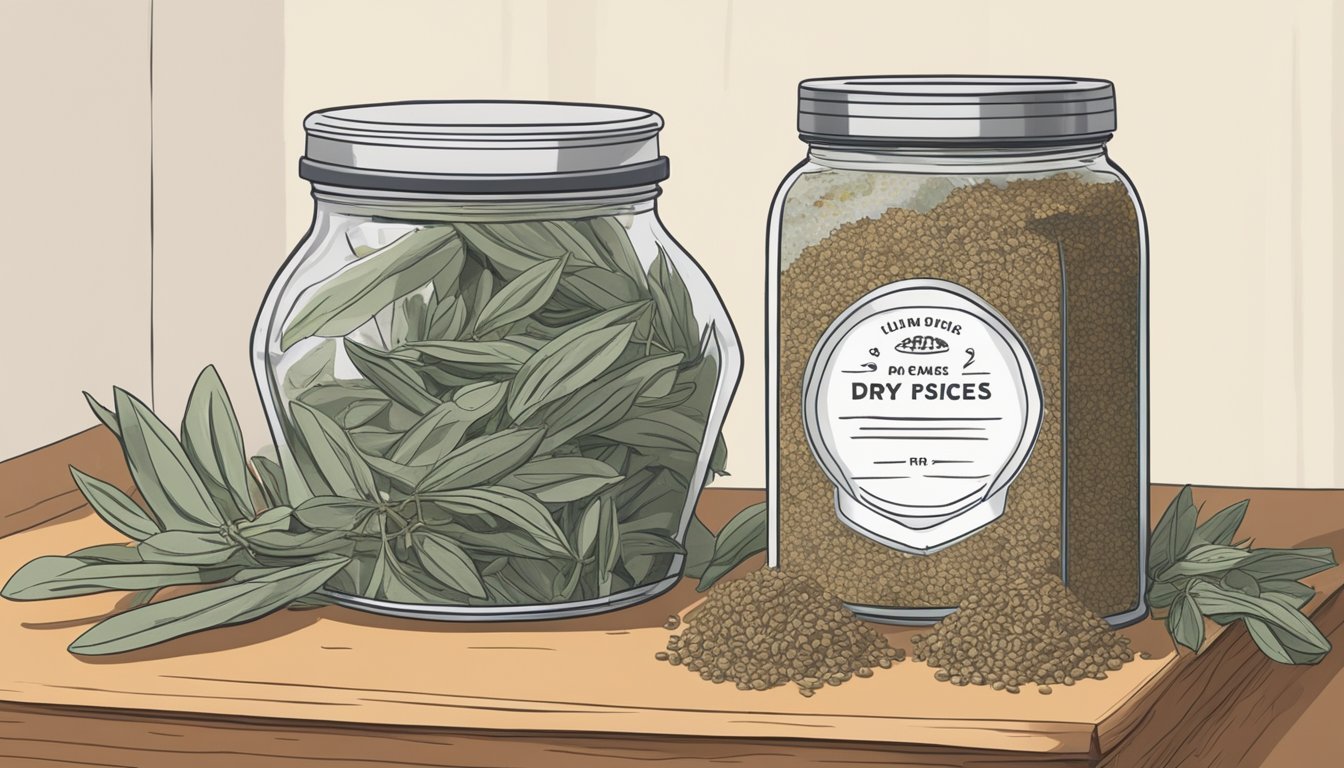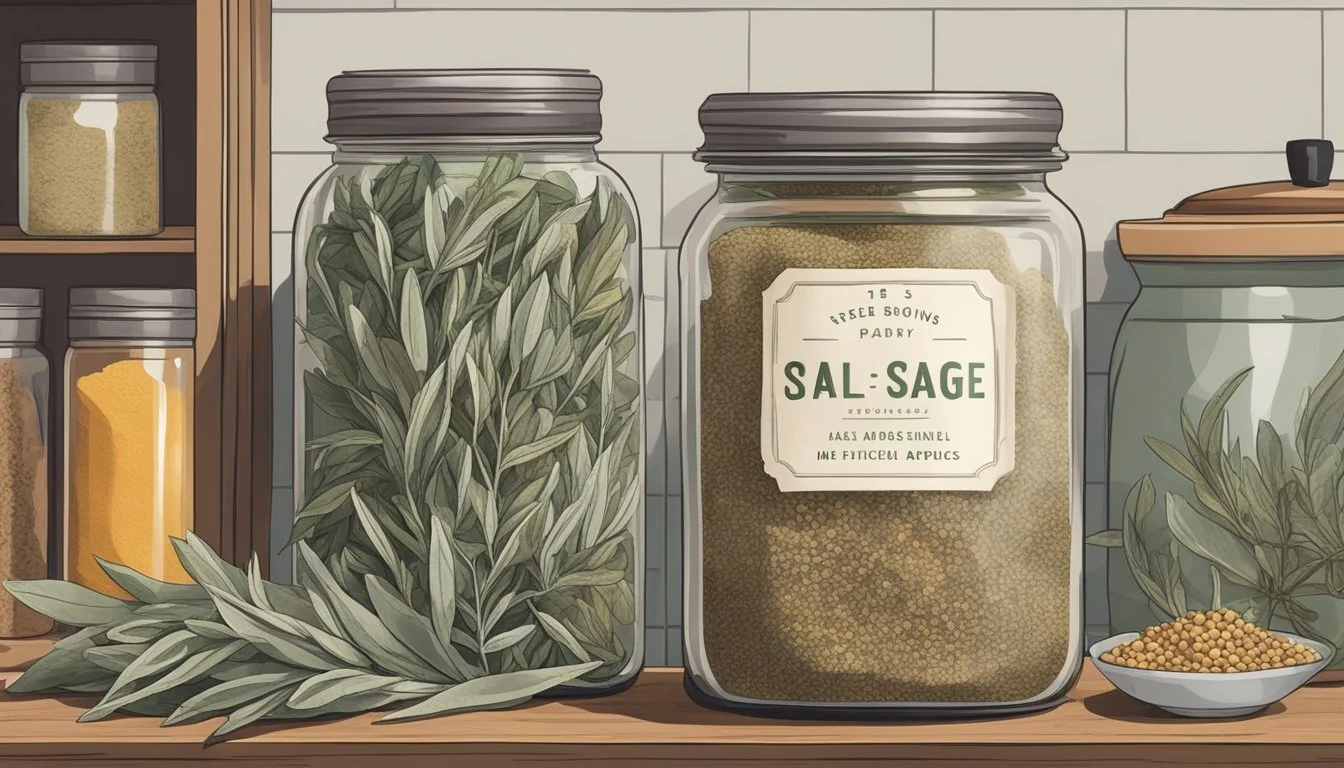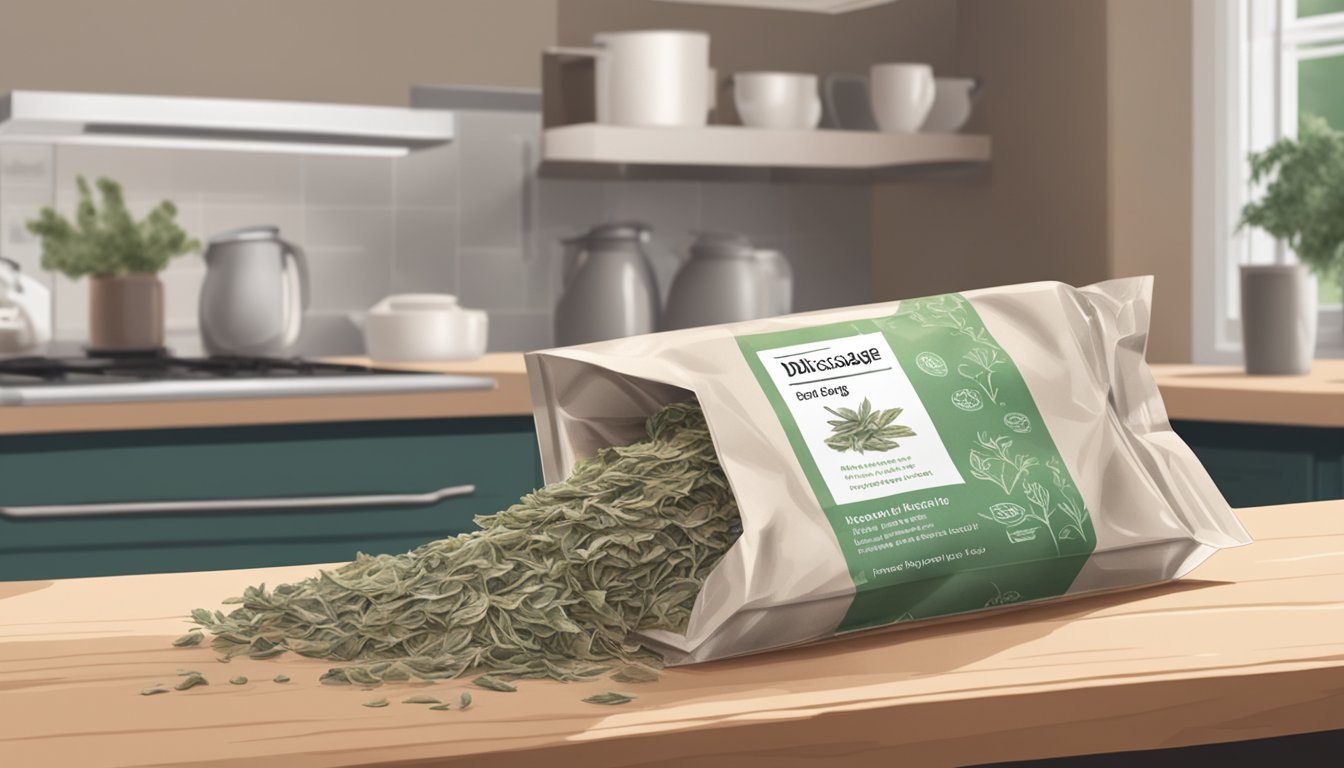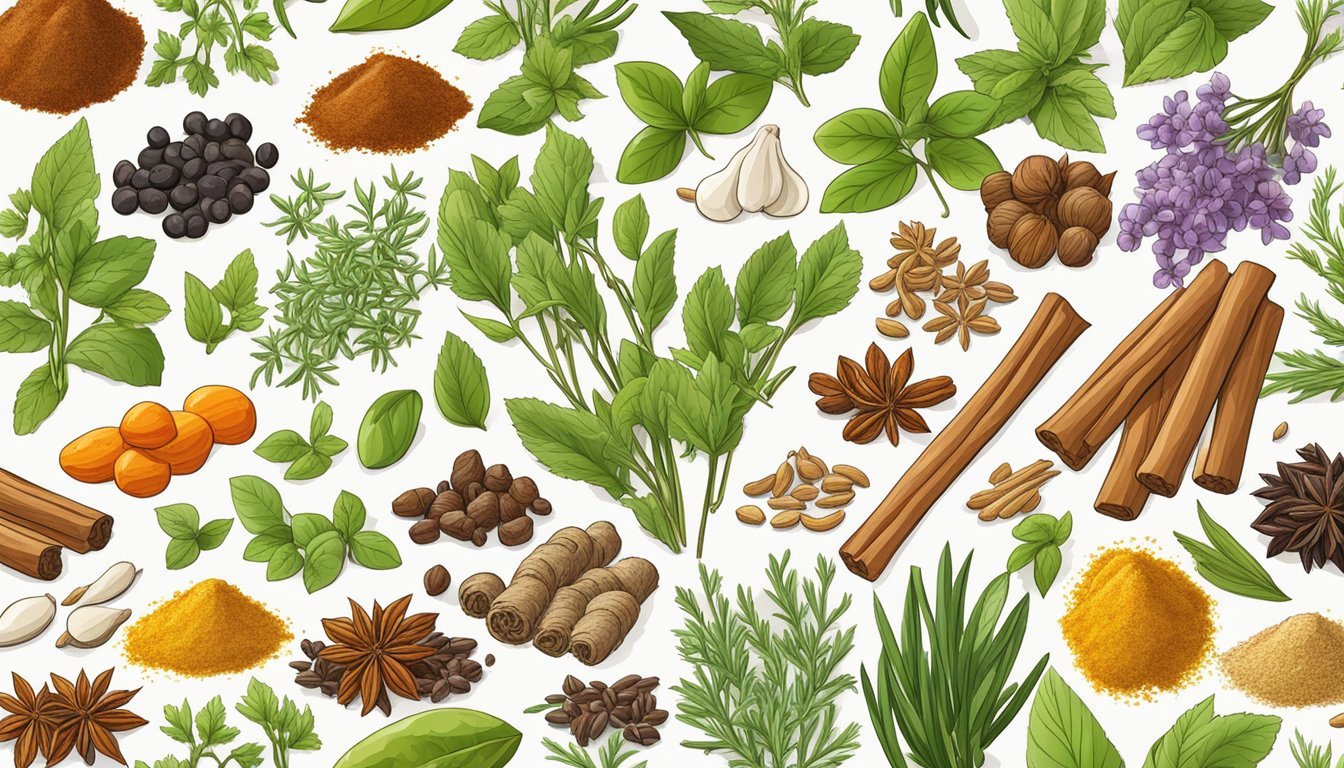How Long Does Dried Sage Last?
Shelf Life and Storage Tips
Dried sage (how long does dried sage last?) is a popular herb known for its aromatic properties and culinary uses, often cherished for its ability to add earthy flavors (What wine goes well with earthy flavors?) to a variety of dishes. As a staple in spice cabinets, its longevity is of interest to many home cooks and professional chefs alike. Generally, dried sage maintains its best quality for about 1 to 3 years when stored properly. This is contingent upon several factors, including the form of the sage—whether ground or whole leaves—and the storage conditions it is kept in.
The shelf life of dried sage can be extended if it is kept in an airtight container and placed in a cool, dark, and dry environment. The preservation of its potency, however, is not indefinite. Over time, dried sage may lose the intensity of its flavor and aroma, which are critical to its culinary value. It's important for users to recognize the signs of aging in spices, as the sensory qualities of sage—its scent and taste—diminish over time.
Understanding the shelf life of dried sage is essential for culinary enthusiasts looking to ensure that their dishes maintain the desired flavor profile. While dried sage does not spoil in the traditional sense, as it does not harbor pathogenic bacteria that can cause foodborne illness, its quality and effectiveness as a seasoning can diminish. Therefore, periodic assessment of its potency is beneficial for optimal use in cooking.
Understanding Sage
Sage, a perennial herb with a distinctive aroma and earthy flavor, is integral to various culinary and medicinal practices. It is available in several varieties and is lauded for its health benefits, particularly due to its antioxidant properties.
Sage Varieties
Sage (Salvia officinalis) comes in numerous species each with unique characteristics. The two most common types are:
Common sage, also known as garden sage, is widely used in cooking.
Spanish sage is preferred for its decorative qualities and aromatic leaves.
These varieties can subtly influence the flavor and potential health benefits of the herb.
Health Benefits
Sage has been historically appreciated for its health benefits:
It is rich in antioxidants, which can help to reduce oxidative stress in the body.
Consuming sage can contribute to overall health by possibly enhancing brain function and memory.
Sage's role in wellness is supported by its incorporation in traditional medicine and its ongoing study in contemporary health research. The herb is often consumed as a spice, tea, or supplement.
Basics of Storing Dried Sage
Storing dried sage correctly is crucial to maintain its quality and flavor. The longevity and potency of dried sage largely depend on the conditions under which it is stored.
Optimal Storage Conditions
Dried sage should be stored in airtight containers with tight-fitting lids to protect it from moisture. The best places to store dried sage are in a cool, dry place, such as a pantry or a cupboard away from heat sources. Maintaining a consistent temperature is important to preserve the herb's qualities.
Ideal Locations: Pantry, cupboard, or a drawer that is dark and has stable temperature.
Container Preferences: Glass or plastic containers with secure lids are recommended.
Effects of Moisture and Heat
Moisture is one of the biggest threats to the potency of dried sage, as it can lead to mold and bacterial growth. Heat can also degrade the herb's essential oils, diminishing its flavor and aroma.
Humidity: Keep it away from humid areas to prevent clumping and spoilage.
Temperature Control: Avoid storing sage near stoves, ovens, or in areas which experience significant temperature fluctuations.
Impact of Light Exposure
Exposure to light, especially direct sunlight, can cause the dried sage to lose its color and potency more quickly. It's ideal to store sage in containers that block out light or in parts of the storage area that do not receive light.
Light Sensitivity: Store in opaque or dark-colored containers to minimize light penetration.
Avoiding Sunlight: Do not place sage in areas that receive direct sunlight, like window sills.
Dried Sage Longevity
Dried sage, known for its aromatic and flavor-enhancing properties, has an impressive shelf life when stored correctly. To ensure the finest quality, understanding the shelf life and the factors that affect its potency is crucial.
Determining Shelf Life
The shelf life of dried sage leaves (how long do dried sage leaves last?) typically ranges between 1-3 years, assuming that the leaves are stored properly. To determine if sage is still of good quality, observe its flavor and aroma; these are strong indicators of its potency. If the dried sage has a muted scent and a lackluster taste, it might be past its prime. While not necessarily harmful, older dried sage may not impart the desired effect in culinary applications.
Factors Affecting Potency
Several key elements influence the potency and longevity of dried sage:
Storage Conditions: For optimal shelf life, dried sage should be stored in an airtight container to protect it from moisture and to maintain its quality. Ideally, the container should be placed in a cool, dark environment such as a pantry or cupboard, away from heat sources and sunlight.
Environmental Exposure: Direct exposure to light and heat can lead to a deterioration in the aroma and flavor. Limiting exposure to such conditions helps to preserve the sage's quality.
Humidity: Keeping the leaves dry is essential as moisture can promote mold growth.
To maximize the shelf life and efficacy of dried sage, closely monitoring these factors is advised.
Identifying Signs of Spoilage
When dried sage begins to deteriorate, its appearance, texture, and aroma are altered. Proper identification of spoilage ensures both the flavor and safety of this herb in culinary use.
Visual and Textural Changes
Appearance and texture offer the first clues to the quality of dried sage. Sage is prone to spoilage when exposed to excess moisture which can be evident through clumping and a noticeable change in color, usually a darkening of the leaves. If one observes any visible mold or moldy spots, the sage should not be consumed.
Smell and Taste Test
Performing a smell and taste test is pivotal to determine the freshness of dried sage. Fresh dried sage should have a robust, aromatic fragrance. If its normally pungent aroma is weak or has an off smell, it's a strong indication that the sage has begun to go bad. The flavor should also be checked; a lack of taste or a noticeable decrease in potency suggests it's time for the sage to be replaced.
When to Replace Dried Sage
If the visual, textural, or sensory tests indicate spoilage, it is essential to replace the herb to maintain quality in cooking and to prevent spoilage. Generally, dried sage should be refreshed when there's a compromise in sensory attributes or every 1 to 3 years as its potency decreases with time.
Usage of Dried Sage
Dried sage plays a versatile role in culinary practices and has alternative uses beyond cooking that capitalize on its aromatic properties.
Culinary Applications
Tea: Dried sage leaves can be steeped to make sage tea, a beverage appreciated for its potential health benefits and its robust, earthy flavor.
Oven Use: When cooking, sage is frequently incorporated in oven-based dishes. It imparts a distinct herbal note to roasted meats (What wine goes well with roasted meats?) and vegetables. For optimal flavor, dried sage should be added at the beginning of the cooking process to withstand high oven temperatures.
Seasoning Blends: Sage often features prominently in seasoning blends. It pairs well with oregano, thyme, and rosemary, enhancing the overall taste of the blend.
Marinades: The inclusion of dried sage in marinades not only infuses meats with its characteristic flavor but may also contribute to the tenderization of the meat fibers.
Stuffing: Sage is a traditional ingredient in stuffing, especially for poultry, where its flavor complements the savory notes of the dish.
Dried Leaves: As a stand-alone seasoning, dried sage leaves can be crumbled and sprinkled directly into a dish, or they might be ground to integrate more uniformly within a recipe.
Alternative Uses
Beyond the kitchen, dried sage has a number of alternative uses, often tied to its aromatic qualities.
Sage Bundles: Bundles of dried sage leaves, commonly referred to as smudge sticks, are burned for their smoke, which is believed to have cleansing properties.
Aromatic Properties: The characteristic fragrance of sage makes it a choice ingredient for homemade potpourris, imparting a comforting and familiar scent to living spaces.
In different contexts, the applications of dried sage showcase its adaptability both in culinary arts and in practices that emphasize its aromatic virtues.
Comparing Sage to Other Herbs
When evaluating the shelf life of dried herbs, it's essential to understand how sage compares with other common herbs like oregano and rosemary, and its role in herb blends.
Sage vs. Oregano and Rosemary
Sage, when dried, generally maintains its potency for up to six months under ideal conditions. This is similar to oregano and rosemary, which also possess a significant shelf life, often extending to a year or more if they are stored in airtight containers away from light and heat.
Oregano typically has a robust flavor that can endure the drying process well, retaining its strong aromatic qualities.
Rosemary shares this resilience; however, its pine-like, peppery flavor can sometimes intensify after drying.
These herbs, including sage, are less prone to spoilage due to their low moisture content after the drying process, but their flavors will degrade over time.
Sage in Herb Blends
The inclusion of sage in herb blends provides an earthy and slightly peppery profile. Its distinct flavor is crucial in many spice mixes, where it works in harmony with herbs like thyme, basil, and parsley.
Thyme brings a subtle, dry aroma and a somewhat minty flavor, which complements sage’s robust taste.
Basil adds a sweet and fresh note, which can balance the strength of sage.
Parsley, often used for its bright herbaceous notes, offers a light, fresh flavor that contrasts the intensity of sage.
Herbs such as dill (how long does dill last?), mint, and clove may be used for specific culinary applications, but they differ significantly from sage in terms of flavor. Dill has a grassy and anise-like taste, mint is recognized for its cooling effect, and clove exhibits a pungent, sweet spiciness. These flavors do not directly compare to sage but can still be an integral part of diverse herb blends.
Proper Storage Methods
Proper storage is essential for maintaining the quality of dried sage. Specific methods such as using airtight containers, freezing, and maintaining dry conditions can significantly extend its shelf life.
Using Airtight Containers
Airtight containers are paramount when storing dried sage to prevent exposure to air, which can diminish its flavor and aroma. For optimal freshness, one should store sage in a tightly sealed container and place it in a dark cupboard away from light, which can degrade its quality. Ground sage, due to its finer particles, is especially susceptible to loss of flavor and should always be stored in an airtight container.
Freezing Dried Sage
To further preserve its qualities, one can freeze dried sage. By doing so, its shelf life can be extended up to two years. It's important to ensure the sage is completely dry before freezing to prevent ice crystals from forming. Place the dried sage in an airtight container or a freezer-safe bag, ensuring all the air is squeezed out before sealing.
Maintaining Dry Conditions
Dried sage retains its quality best in dry conditions. Any moisture can lead to mold growth and a loss of flavor and potency. One should ensure that the storage area is not prone to humidity and that the containers used are completely dry before placing sage inside. This helps to preserve the structural integrity and aromatic oils of the dried herb, thus prolonging its shelf life.
Other Considerations
In understanding the longevity of dried sage, it is pertinent to consider its different forms and compare it with the fresh counterpart. Storage techniques and shelf life vary notably depending on whether the sage is fresh, dried, or ground.
Dried vs. Fresh Sage
Dried sage is significantly different from fresh sage in terms of shelf life. Fresh sage should be used within a week or two when stored in the refrigerator. In contrast, dried sage, which refers to sage leaves that have been dehydrated, can last much longer. It typically retains quality for about 1 to 3 years if stored properly in airtight containers, away from heat and light. One should note that the potency of dried herbs, including sage, diminishes over time, so using it within the first year is often recommended for optimal flavor.
Ground Sage Recommendations
When sage is ground, the surface area increases, and it becomes more exposed to air, which can speed up the loss of flavor and potency. Ground sage, therefore, has a shorter shelf life than whole dried leaves. Consumers are advised to use ground sage within six months to ensure it maintains its characteristic aroma and taste. To preserve the full flavor, store ground sage in a cool, dark place in a tightly sealed container. Like all dried herbs, ground sage should be kept away from moisture, heat, and direct sunlight to preserve its quality.
Complexity of Flavors
Dried sage has a robust, earthy flavor, and subtle shifts in its freshness can significantly influence the taste of culinary dishes.
Sage in Spice Mixes
When sage is incorporated into spice mixes, its presence contributes a layer of complexity to the blend. Given the prolonged shelf life of dried sage, typically 1 to 3 years, one should assess its potency before use in mixes. As it ages, sage may lose some of its piquancy, which could lead to a diluted flavor profile in the mix. Cooks often use sage in balanced proportions with other spices, and if its strength wanes, it could upset the intended flavor balance. A simple test for freshness involves:
Visual Inspection: Fresh sage should retain its original color, without signs of fading.
Aromatics: Crush a small leaf and smell it; a potent aroma suggests that the sage is still flavorful.
For optimal flavor retention, store dried sage in airtight containers, away from light and heat. In spice mixes, it is crucial to ensure all components maintain their integrity for a harmonious final product.










